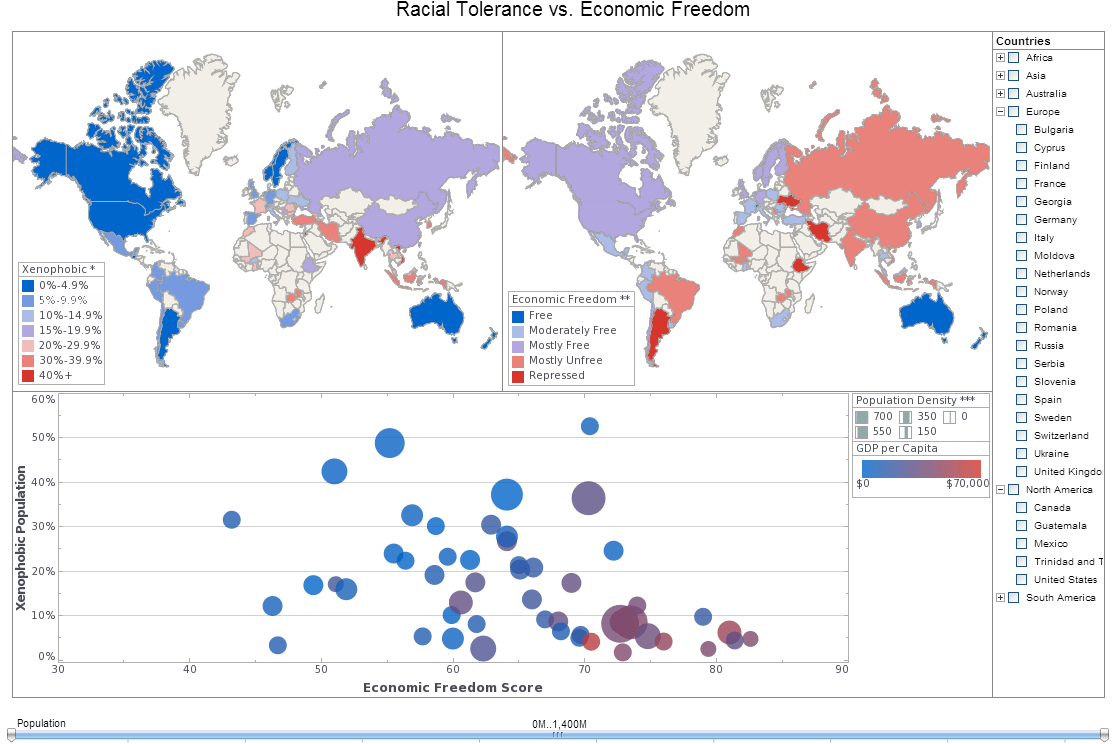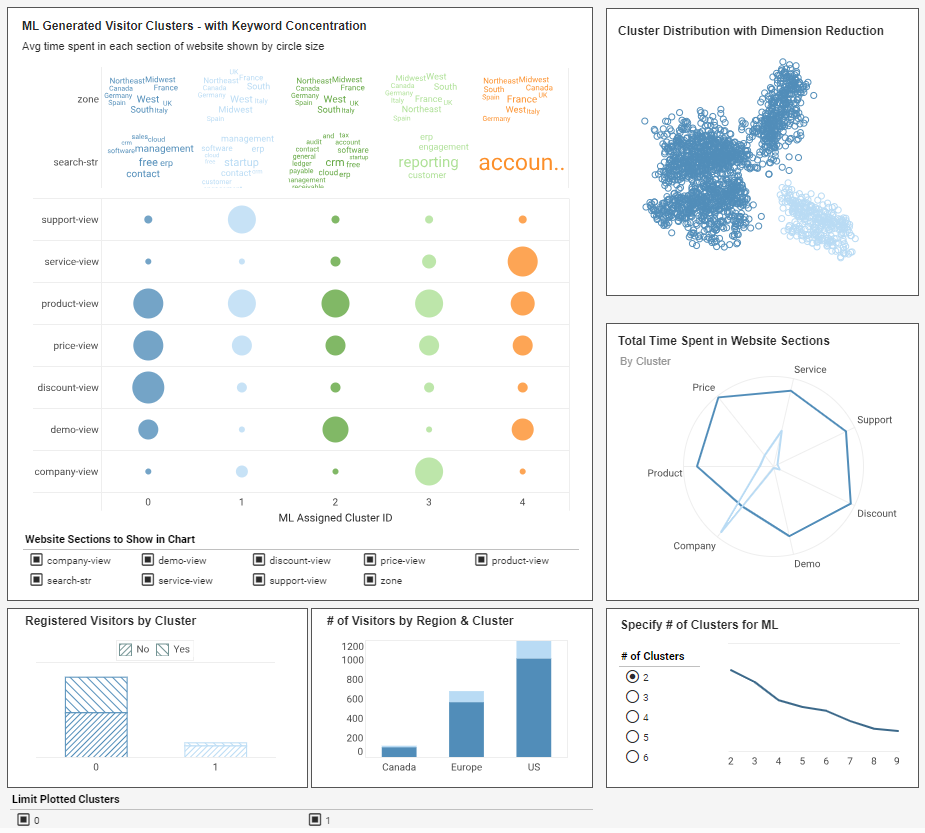Ad Hoc Business Intelligence and Self-Service Reporting
StyleBI, InetSoft's flagship BI product, is a complete business intelligence suite, with a heavy focus on end-user self-service.
A large number of application software systems utilize 'production reporting.' These programs are bound by their limited access to a database through pre-programmed menus.
StyleBI, on the other hand, allows you to create specific, customized queries without in-depth IT knowledge. With this level of self-service, you can answer very targeted business questions that production report developers may not have even considered.
Ad Hoc analysis can be used to create new reports or drill deeper into created reports for additional detail.


Point-and-Click Data Analysis | Online Analytical Processing
StyleBI provides an integrated OLAP front-end that offers access to applications such as Microsoft SQL Server Analysis Services, Hyperion ESSbase, Oracle OLAP, SAP NetWeaver and dozens more.
End-User Defined | Data Mashup for Everyone
End-user defined data mashup lets you combine disparate data sources within a data warehouse schema.
Throw away the misconception that IT be the gatekeeper of this data. Limiting the number of end-users creates obstacles to delivering the fullest benefits of business intelligence, and as such, we have designed Style Intelligence to be accessible to all users, regardless of IT background or training.
How an Event Safety Manager Uses Ad Hoc Business Intelligence
An event safety manager plays a critical role in ensuring the well-being of attendees, staff, and participants during various events. Ad hoc business intelligence (BI) can significantly aid in this endeavor by providing timely and actionable insights to enhance safety measures and decision-making processes. Here's how an event safety manager can utilize ad hoc BI:
-
Real-Time Monitoring: Ad hoc BI tools enable event safety managers to monitor various data sources in real-time, such as weather forecasts, attendee behavior patterns, and crowd movement. By analyzing this data on-the-fly, managers can identify potential safety risks and take proactive measures to mitigate them. For example, if sudden adverse weather conditions are predicted, the manager can quickly adjust outdoor event plans to ensure attendee safety.
-
Risk Assessment: Ad hoc BI allows for quick analysis of historical data related to past events, incidents, and emergencies. By identifying patterns and trends, safety managers can conduct more accurate risk assessments for current events. This information can help in determining the necessary safety protocols, staffing levels, and resource allocations to minimize risks and ensure a safe environment for all attendees.
-
Resource Optimization: Ad hoc BI tools enable event safety managers to optimize resource utilization by analyzing data related to staff availability, equipment deployment, and emergency response protocols. By identifying areas of inefficiency or potential bottlenecks, managers can make informed decisions to allocate resources more effectively, ensuring that sufficient personnel and equipment are available to handle any emergencies that may arise during the event.
-
Emergency Response Planning: Ad hoc BI facilitates dynamic emergency response planning by providing up-to-date information on various factors such as crowd density, traffic congestion, and medical emergencies. This allows safety managers to adjust their response strategies in real-time to address emerging threats and ensure a coordinated and efficient response to any incidents.
-
Compliance Monitoring: Ad hoc BI tools can help event safety managers ensure compliance with relevant safety regulations and guidelines by monitoring key performance indicators (KPIs) in real-time. By tracking metrics such as crowd capacity, emergency response times, and incident rates, managers can identify areas where compliance may be lacking and take corrective actions to address any issues promptly.
-
Post-Event Analysis: After the event, ad hoc BI can be used to conduct comprehensive post-event analysis to evaluate the effectiveness of safety measures and identify areas for improvement. By analyzing data on incident reports, attendee feedback, and emergency response times, managers can gain valuable insights into what worked well and what can be done better in future events to enhance safety and overall attendee experience.
More Articles About Business Intelligence
-
Harnessing Machine Learning To Expand Business Intelligence Capabilities
This article explains how machine learning integrated with business intelligence software can significantly enhance an organization’s ability to surface actionable insights from diverse data sources. It emphasizes the competitive edge gained when BI platforms use ML to automate pattern recognition and continuously refine analytics. The piece includes examples of real-world applications, illustrating how major brands leverage intelligent BI systems to improve operational outcomes. It also outlines broader trends showing increased adoption of ML-powered BI tools across industries. The insight is that machine learning isn’t just a buzzword but a transformative force that expands the reach and power of business intelligence.
-
Exploring Emerging BI And Data Analytics Trends For 2026 And Beyond
This article identifies key trends shaping the future of business intelligence and data analytics, such as tightening data privacy regulations and the rise of immersive technologies like the metaverse. It discusses how AI and ML will continue to advance BI tools while still requiring human insight, making analytics both automated and interpretable. The piece highlights the importance of data storytelling through interactive dashboards that make insights understandable across teams. It also underscores the necessity for businesses to adapt their BI practices to remain competitive in rapidly evolving tech and regulatory landscapes. Overall, the article provides a forward-looking perspective on where BI is headed and what innovations to watch.
-
Accelerating Decision Making With Intuitive Operational Business Intelligence
This article explores how operational business intelligence with an intuitive user interface can empower business users to interact with data without deep IT support. It highlights features like real-time dashboards, reporting, and visualization that facilitate quicker insights for decision makers. The piece also explains how data block technology simplifies accessing diverse data sources, allowing dynamic data mashup and transformation. Operational BI’s role in increasing profitability, analyzing customer behavior, and optimizing operations is emphasized. The content makes a strong case for embedding BI into daily workflows to improve responsiveness and agility across the organization.
-
Aligning Business And IT Priorities When Creating A Business Intelligence Strategy
This article delves into the nuances of crafting a business intelligence strategy that aligns both IT and business executives around common objectives. It discusses how misalignment between technology and business goals can hinder BI maturity and proposes structured approaches to close that gap. The piece offers concrete signs that an organization may lack an effective BI strategy, such as an over-focus on architecture over analytics needs. It also presents best practices for building a strategy that enables cohesive data initiatives and stronger decision-making. The emphasis is on strategic alignment as a prerequisite for successful BI deployment.
-
Utilizing BI In Data Warehousing Environments For Unified Dashboards
This article discusses how business intelligence solutions integrated with data warehousing environments can unify disparate data sources and provide interactive dashboards and reporting. It highlights that BI tools can access various data repositories like relational databases, ERP systems, and flat files through standard connectors. The piece also emphasizes the ease of use for business users, requiring minimal specialized technical skills. It explains how self-service BI and interactive analysis can scale with organizational needs. Overall, it positions a BI-enabled data warehouse as central to consistent, high-quality analytics across an enterprise.
-
Illustrating 6 Real-World Cases Where Business Intelligence Drives Value
This article presents real-world examples showing how business intelligence solutions deliver strategic and operational value across various business functions. It demonstrates how BI improves decision-making by providing historical, real-time, and predictive visualizations. The content highlights cases where BI helped organizations streamline operations, enhance customer loyalty, and optimize performance management. It emphasizes that BI not only supports strategic insights but also operational improvements that lead to measurable growth. This narrative reinforces BI’s role as a practical tool for achieving business goals.
-
Defining A Roadmap When Setting A Business Intelligence Strategy
This article extends the discussion on BI strategy by focusing on the roadmap to achieve a future state where analytics meaningfully supports business goals. It emphasizes collaboration between business and IT to define useful metrics and requirements for successful BI initiatives. The piece also discusses aligning BI vision with organizational priorities and justifying investment in BI solutions. It underscores the importance of a clearly defined strategy for deploying enterprise BI tools that meet diverse needs. The overall message is that a solid roadmap is essential for BI success and organizational coherence.
-
Compiling A List Of Business Intelligence Topics And Challenges
This resource page provides a curated list of topics related to business intelligence, including the challenges enterprises face when deploying BI solutions. It frames the core issues around data accessibility, contextual relevance, and the need for agile BI models beyond one-size-fits-all solutions. The piece also touches on why manual data collection processes limit BI effectiveness and how contextual BI can improve actionable insights. It’s valuable for understanding broad BI concerns that influence how organizations adopt and scale analytic solutions. The content emphasizes the need for BI tools that adapt to diverse user needs and data contexts.
-
Evaluating BI Software With Small-Footprint Architecture For Easier Deployment
This article discusses the benefits of business intelligence software that features a small-footprint architecture for rapid deployment and ease of use. It highlights how such BI platforms can serve both executive and power users while remaining flexible enough to adapt to organizational needs. The piece underscores that ease of deployment and learning are crucial for maximizing BI adoption and user satisfaction. Practical insights include how agile BI supports changing business needs through visualization and self-service analysis. The narrative positions small-footprint BI as a strategic choice for organizations seeking faster time to insight without heavy infrastructure investment.
-
Understanding The Fundamentals Of Turning Data Into Strategic Insight
This article provides a foundational overview of business intelligence, defining it as the process of turning data into insights that drive decision-making and performance improvement. It discusses core BI components, including data structure, insight generation, and best practices for establishing BI competency across an organization. The piece also explores how dynamic, real-time data streams have transformed BI from static reporting into agile analytic practices. The narrative offers a broad understanding of BI’s role in modern businesses. This resource helps readers grasp what BI entails and why it’s important for organizational success.
-
Incorporating Web Analytics Into Broader Business Intelligence Workflows
This article explains how business intelligence platforms can integrate web analytics data with other enterprise systems to provide unified insights and dashboards. It highlights the value of combining web metrics with CRM or ERP data for a holistic view of customer journeys and performance indicators. The piece also emphasizes the importance of interactive, customizable visualizations that business users can create without extensive technical knowledge. It underscores how BI tools democratize analytics across roles, enabling marketers to explore data independently. The article showcases the practical benefits of merging web analytics into a comprehensive BI strategy.
